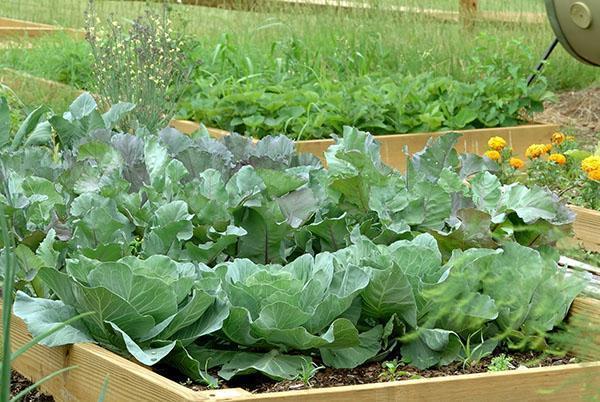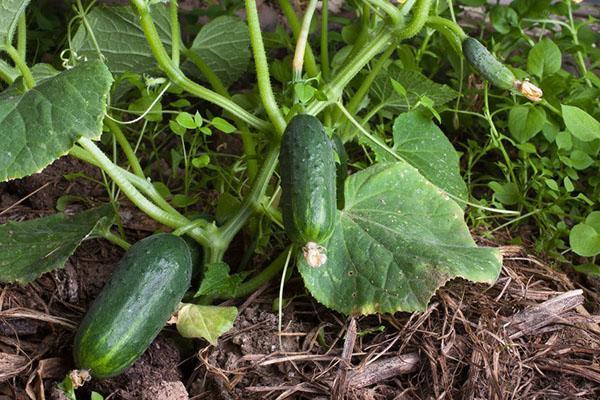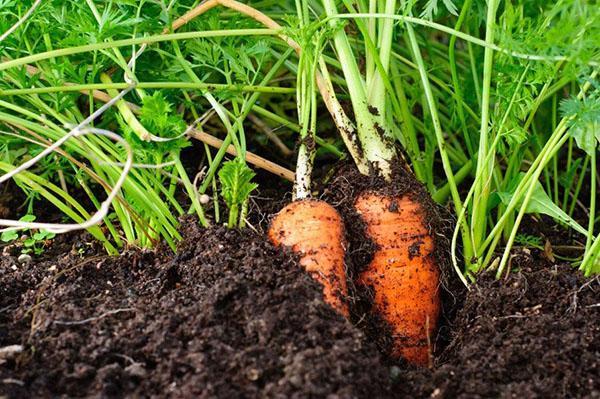Summer resident's calendar: July in the garden beds
 July is the top of summer, and the summer resident's business is not diminishing. The garden, if not kept track, quickly twitches with weeds. And growing crops lure a variety of insects, including dangerous pests. More and more energy is given to watering and feeding. And yet, in a series of July concerns, the gardener has pleasant chores - this is the beginning of a massive harvest of vegetables.
July is the top of summer, and the summer resident's business is not diminishing. The garden, if not kept track, quickly twitches with weeds. And growing crops lure a variety of insects, including dangerous pests. More and more energy is given to watering and feeding. And yet, in a series of July concerns, the gardener has pleasant chores - this is the beginning of a massive harvest of vegetables.
The harvest of vegetables in the July vegetable garden

Regular harvest stimulates the formation of new ovaries and increases the yield of plants.
The same rule applies to zucchini and squash, which have long been among the favorite vegetables of Russians and are ready for a massive harvest in July.
 Lovers of beetroot and summer borscht can enjoy healthy soups made entirely from fresh vegetables. Among the vegetables of July fruiting, early cabbage, and not only white cabbage, but also cauliflower, Savoy and kohlrabi... If a Bouquet of fragrant greens, including parsley, dill, celery, could have been picked back in June, then by mid-summer it had already filled up in the gardens of the middle lane beet and carrots. The first tomatoes appear in July.
Lovers of beetroot and summer borscht can enjoy healthy soups made entirely from fresh vegetables. Among the vegetables of July fruiting, early cabbage, and not only white cabbage, but also cauliflower, Savoy and kohlrabi... If a Bouquet of fragrant greens, including parsley, dill, celery, could have been picked back in June, then by mid-summer it had already filled up in the gardens of the middle lane beet and carrots. The first tomatoes appear in July.
It's time to harvest the early young potatoes. Tubers with a thin, fragile skin are not yet ready for long-term storage, they quickly dry out and lose their presentation. Therefore, it is better to dig in the bushes in the early morning hours, in the evening or in cloudy weather, and store potatoes for no more than 3-4 days.
In order for the bush to continue to produce a crop, it is not dug out entirely, but is carefully dug in, slightly exposing the root system. After sampling the tubers, the soil is returned to its place and the plant is watered.
Watering garden crops in July
 Almost all the inhabitants of the garden require water at the peak of summer. Therefore, watering in the summer resident's calendar for this month is one of the most important tasks. So that the work is not in vain, the beds are watered in the morning or evening hours with warm water so that the soil under the plants is saturated with moisture to a depth of at least 15–20 cm.
Almost all the inhabitants of the garden require water at the peak of summer. Therefore, watering in the summer resident's calendar for this month is one of the most important tasks. So that the work is not in vain, the beds are watered in the morning or evening hours with warm water so that the soil under the plants is saturated with moisture to a depth of at least 15–20 cm.
Cucumbers and tomatoes, sweet peppers and others are especially dependent on water at the time of ovary formation. eggplant... The latter, if they feel a lack of moisture, quickly get rid of the already set small fruits, flowers and even buds. You can stimulate fruit setting by combining watering with feeding once every 10 days. In addition to organics, potassium rich is added to the liquid wood ash at the rate of 100 grams of fertilizer per bucket of irrigation water. You can hear that tomatoes should be limited in water practically from June. This is not true. In order for a plant to set and bear a decent harvest, 10 liters of water should fall per meter of area in July. The frequency of watering is adjusted according to the weather, preventing the root system of fruiting bushes from drying out.
The hotter July, the more intensive the watering. In cool, cloudy weather, soil evaporation and plant needs are reduced. This means that the summer resident can devote more time to other concerns.
Plant care in July
 In order for the first tomatoes to hit the table as soon as possible, the plants are stepchild.The lower, gradually aging leaves, as well as greenery that grows inside the bush and prevents it from airing, are subject to removal. The second half of summer is often threatened by cold nights and the spread of late blight. In areas where there is a high risk of such a loss of yield, or the plants no longer have enough heat, it is advised to pinch the tops in July. This measure will allow you to properly fill and ripen the resulting ovary.
In order for the first tomatoes to hit the table as soon as possible, the plants are stepchild.The lower, gradually aging leaves, as well as greenery that grows inside the bush and prevents it from airing, are subject to removal. The second half of summer is often threatened by cold nights and the spread of late blight. In areas where there is a high risk of such a loss of yield, or the plants no longer have enough heat, it is advised to pinch the tops in July. This measure will allow you to properly fill and ripen the resulting ovary.
 Hilling helps to improve the nutrition of crops such as tomatoes and potatoes. This work is combined with weeding and feeding. Weed control is carried out on all beds. In the middle of summer, while there is time until autumn, weeding can thin out carrots, beets, root parsley and other root crops.
Hilling helps to improve the nutrition of crops such as tomatoes and potatoes. This work is combined with weeding and feeding. Weed control is carried out on all beds. In the middle of summer, while there is time until autumn, weeding can thin out carrots, beets, root parsley and other root crops.
July pinch pumpkin in the garden helps to get a fully ripe crop by autumn. For this, the lashes of the plants are shortened by cutting off after the formed ovaries. The amount of pumpkin that should be left is determined based on the characteristics of the variety. The larger the fruits, the less they can grow and ripen.
Massively fruiting cucumbers in July are not only watered, but also fed. To do this, it is rational to use liquid specialized fertilizers, which immediately go to the roots and are used by plants.
Loosening the soil under cucumber bushes is undesirable. But the plants will be happy to add loose soil. In this case, they will be able to form additional roots and receive a little more moisture and nutrition.
Although the main planting work has already been completed in July, it is too early to lay off seed stocks. As soon as the day begins to shorten, you can sow radish, daikon, autumn salads, Chinese cabbage. From the second half of July, these plants will have much less opportunity to bloom ahead of time.
Processing a vegetable garden in July from pests and diseases
 In July, garden beds are good not only for cultivated plants, but also for pests, pathogens, and weeds. With all this uninvited "population" you have to fight carefully and systematically, otherwise you won't have to wait for an excellent harvest.
In July, garden beds are good not only for cultivated plants, but also for pests, pathogens, and weeds. With all this uninvited "population" you have to fight carefully and systematically, otherwise you won't have to wait for an excellent harvest.
From the second decade of July, cabbage scoops appear on the beds. Butterflies themselves do no harm, but their larvae are the worst enemies of all types of cabbage, as well as cabbage flies flying out at the same time. Onion flies can be seen above the onion in mid-summer. If you do not process the ridges in time, because of these subtle pests, you can miss the lion's share of the harvest.
On potatoes, the main pest is the Colorado potato beetle, which also willingly makes its way to the beds with eggplants, bell peppers, and closer to autumn and with tomatoes. Treatment of plantings from insects can be combined with spraying from late blight, and if the year is wet, then from powdery mildew. The procedure is carried out in the evening in dry weather. After 10-12 days, the treatment is repeated. After spraying, you can start harvesting only after 2-3 weeks.